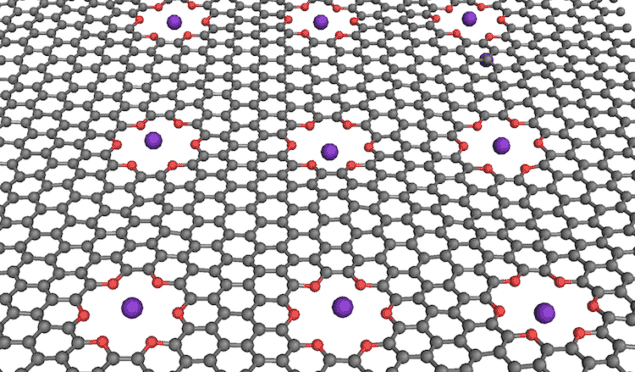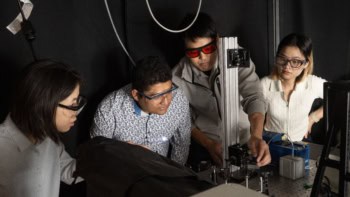
Extensive room-temperature molecular dynamics simulations by researchers at the National Institute of Standards and Technology (NIST) have shown that logic operations might be performed by trapping water-dissolved metal ions in graphene-embedded crown-like pores. As well as making liquid-based computational devices, the set up might also be used in applications such as deionization, ion sensing and sieving, and energy storage.
Crown ethers
The NIST team studied a graphene sheet measuring 5.5 × 6.4 × 5.0 nm containing one or more nanopores lined with oxygen atoms. These pores resemble crown ethers, which are a family of electrically neutral cyclic ethylene oxide molecules that can trap different metal cations depending on the crown size and its composition. Graphene (a 2D sheet of carbon atoms) can naturally embed various types of crown-like pores thanks to its hexagonal symmetry. One such pore is the 18-crown-6-pore, which is produced by removing an entire carbon hexagon, and then replacing the remaining edge carbons with oxygen atoms.
“Such a pore is expected to preferentially bind aqueous potassium (K+) ions over other ions such as sodium or chlorine,” explains Alex Smolyanitsky, who is the lead author of this study.
Ion-based logical operations
In their simulations, the researchers suspended the graphene in water containing potassium chloride. Their calculations showed that when a single potassium ion is trapped in a pore, it prevents other ions from penetrating it. The trapping can be tuned by applying different voltages across the graphene membrane, which suggests that ion-based logical operations could be performed in a conceptually simple way, says Smolyanitsky.
“If we apply a low voltage (denoted “0”) across the membrane at a high K+ concentration, the membrane is nearly non-conductive because its pores are fully occupied by the trapped ions,” he adds. “The charge in the graphene circuit in this case is relatively high (denoted “1”). But, when we apply a high voltage (of more than 300 mV) (denoted “1”), the membrane become highly conductive (ON) because fewer ions are trapped. The membrane subsequently has a low charge (denoted “0”).
“This input-output relationship can be viewed as a NOT logic gate or operation,” he says. “An input of 0 produces an output of 1, and vice versa.”
“Cascaded” circuitry
The researchers found that small changes in applied voltage produce relatively large changes in potential membrane charge or current. This implies that sensitive switching may be possible and that voltage-tuneable ion trapping in the pores might be used to store information – or to make transistors for use in “cascaded” ion-based logic circuitry.
“Cascaded means that the output of one cell is connected to the input of another – that is, one cell controls the other, similarly to transistors in conventional integrated circuits work,” Smolyanitsky tells Physics World.
Not limited to graphene-embedded crowns
The researchers stress that the physics described in this work isn’t limited to graphene-embedded crowns and that, in principle, similar structures are possible in other 2D materials like hexagonal boron nitride (h-BN).
“As well as the applications mentioned, another interesting one may be generating and detecting terahertz radiation,” adds Smolyanitsky. “It just so happens that the resonant frequency of the trapped ions is in the THz range. This could be promising for wireless communications and medical imaging.”
The team, reporting its work in ACS Nano 10.1021/acsnano.8b01692, says that it is now busy looking into atomically symmetric ultra-narrow nanopores in transition metal dichalcogenides (monolayer molybdenum disulphide, for example) and h-BN. “An interesting aspect here is that these materials do not seem to require extra functionalization the way crownlike pores in graphene do – the pore function comes from the material itself,” says Smolyanitsky. “We are also in the early stages of a new collaboration with experimentalist colleagues to pursue a research direction that combines both theory and experiment.”



